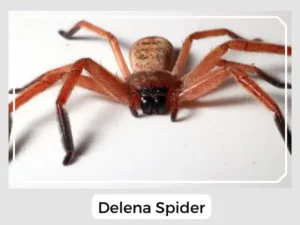The Delena spiders are part of the huntsman spiders family. With around four types in this group, they have some fascinating traits. Get ready to discover interesting facts about them right here!

Photo Credit: Michael Whitehead
The sac is flat and oval, having about 200 eggs on average.
They remain with their mother for a couple of weeks and then drift apart to thrive on their own.
Yes, Delena spiders have venom, but it’s generally not harmful to humans.
Delena spiders can bite if they feel threatened, but it’s rare and their bite is usually not severe for people.
Delena spiders serve as natural pest controllers, feeding on a variety of insects within their habitats. Their hunting activities help keep insect populations in check, contributing to the ecological balance. These spiders prefer dry and dark places, often seeking refuge in the crevices of tree bark or rocks during the day.
Natural Predators: Their natural predators include birds, larger spiders, and other predatory insects. These predators help maintain the natural balance by preventing the overpopulation of Delena spiders.
Prey-Predator Dynamics: In the food web, Delena spiders are crucial predators of insects. Their presence affects the populations of their prey, which in turn impacts the abundance of the predators that feed on them, illustrating the interconnectedness of the ecosystem.
Relationship with Humans: Delena spiders are generally not aggressive towards humans and their venom is not harmful, though they can bite if threatened. However, such incidents are rare. Humans often appreciate these spiders for their role in controlling pests, especially in agricultural and garden settings.
| Lifespan | Approximately two years |
| Distribution | Different parts of Australia and New Zealand |
| Habitat | Dry, dark places |
| Diet | Insects |
In conclusion, Delena spiders are an important part of their ecosystems, serving as both predators and prey.
The Delena spiders are part of the huntsman spiders family. With around four types in this group, they have some fascinating traits. Get ready to discover interesting facts about them right here!

Photo Credit: Michael Whitehead
The sac is flat and oval, having about 200 eggs on average.
They remain with their mother for a couple of weeks and then drift apart to thrive on their own.
Yes, Delena spiders have venom, but it’s generally not harmful to humans.
Delena spiders can bite if they feel threatened, but it’s rare and their bite is usually not severe for people.
Delena spiders serve as natural pest controllers, feeding on a variety of insects within their habitats. Their hunting activities help keep insect populations in check, contributing to the ecological balance. These spiders prefer dry and dark places, often seeking refuge in the crevices of tree bark or rocks during the day.
Natural Predators: Their natural predators include birds, larger spiders, and other predatory insects. These predators help maintain the natural balance by preventing the overpopulation of Delena spiders.
Prey-Predator Dynamics: In the food web, Delena spiders are crucial predators of insects. Their presence affects the populations of their prey, which in turn impacts the abundance of the predators that feed on them, illustrating the interconnectedness of the ecosystem.
Relationship with Humans: Delena spiders are generally not aggressive towards humans and their venom is not harmful, though they can bite if threatened. However, such incidents are rare. Humans often appreciate these spiders for their role in controlling pests, especially in agricultural and garden settings.
| Lifespan | Approximately two years |
| Distribution | Different parts of Australia and New Zealand |
| Habitat | Dry, dark places |
| Diet | Insects |
In conclusion, Delena spiders are an important part of their ecosystems, serving as both predators and prey.